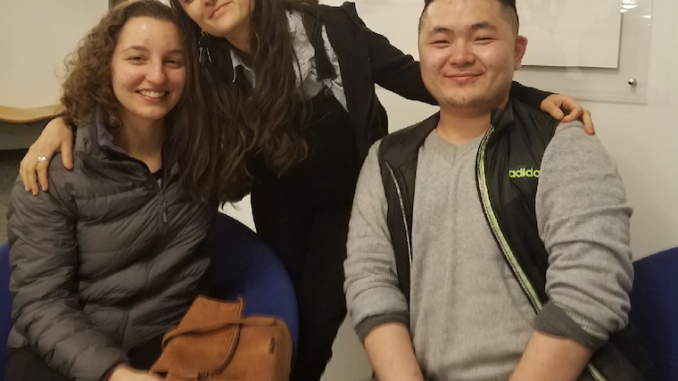
Mina Metreaud carefully wraps her arm around her partner. They both tactically move around each other, their knees slightly bent with rhythmic footwork that seems almost playful. The close embrace and poignant stares serve to emphasize their connection as they attempt to keep the beat of the song as they continue.
Argentine tango is like “having a conversation,” said SUNY New Paltz graduate student Metreaud.“You’re embracing strangers, you have to listen, communicate and slow yourself. It’s a moving meditation.”
Metreaud began tango dancing two years ago at New Paltz and feels that the dance improved her overall being.
“Whatever you need to work out in life, you can work out through tango,” she said. “Dealing with anxiety, connecting with others and gaining confidence.”
Metreaud brought tango to the student body by creating the SUNY Tango Club last semester. The club meets on Wednesdays at 7 p.m. at the Roost Studios and is free for all students.
The club has eight dedicated members so far, with many coming and going as their schedule permits. There is no set choreography or performances in front of audiences. The club is about helping college students find a healthy way to interact and relieve stress from daily life.
Another underlying mission of the club is to defeat harmfulpreconceptions of tango, such as it being primarily danced in Argentina within elite spaces. To provide an introduction to the true roots of tango, Metreaud and dance scholar Nina Jirka teamed up to present the documentary “Tango Negro: The African Roots of Tango.” The documentary by Angolan filmmaker Dom Pedro was shown to students, community members and tango club members on Wednesday in the MPR to show the true origin of tango, “not the tango that is marketable and that people are selling,” Metreaud said.
The documentary explored how the culture of African slaves brought to Argentina and Uruguay, during the slave trade via La Plata River influenced the modern tango we know today. The film also examined how the African roots of the music are often denied in Argentina because of the nation’s history of discrimination and prejudice towards indigenous and African citizens.
African people heavily populated Argentia during 1830-1840 and brought traditional dances from their homeland. Rhythmic drum beats produced music such as candombe, habenera and milongo that were introduced to Argentina, and later became appropriated and white washed to suit an European audience.
In the late 1800s, there was a large migration of European immigrants to Argentina because the government wanted to “civilize” the nation and eradicate its indigenous and African customs that were deemed barbarbic.
Once rich Argentinians saw the acceptance of tango in Paris, the dance and music had a European seal of approval, and later became appropriated and commercialized for a white and elite audience.
Tango club member, Isadora Feilbert saw how tango was depicted as sophisticated and high class in Argentina. She wanted to learn more about the true history of tango and how it has developed by attending the event.
As a foreign exchange student, Feilbert wanted to become involved within the community. Even though she had no experience dancing tango, she decided to join to try something new.
“I was a bit uncomfortable at first because it’s an intimate dance, but through the club I learned to let go,” she said. “Everyone is really understanding and gave me tips on how to grow, it’s a very receptive and welcoming community.”
Both Metreaud and Feilbert acknowledged that at first, tango can seem intimidating because of the amount of physical contact, but the important part is showing up and learning to release tension.
“Tango is a dance about the people. It’s a blend of cultures that brings people together to grow as a community,” Metreaud said.
